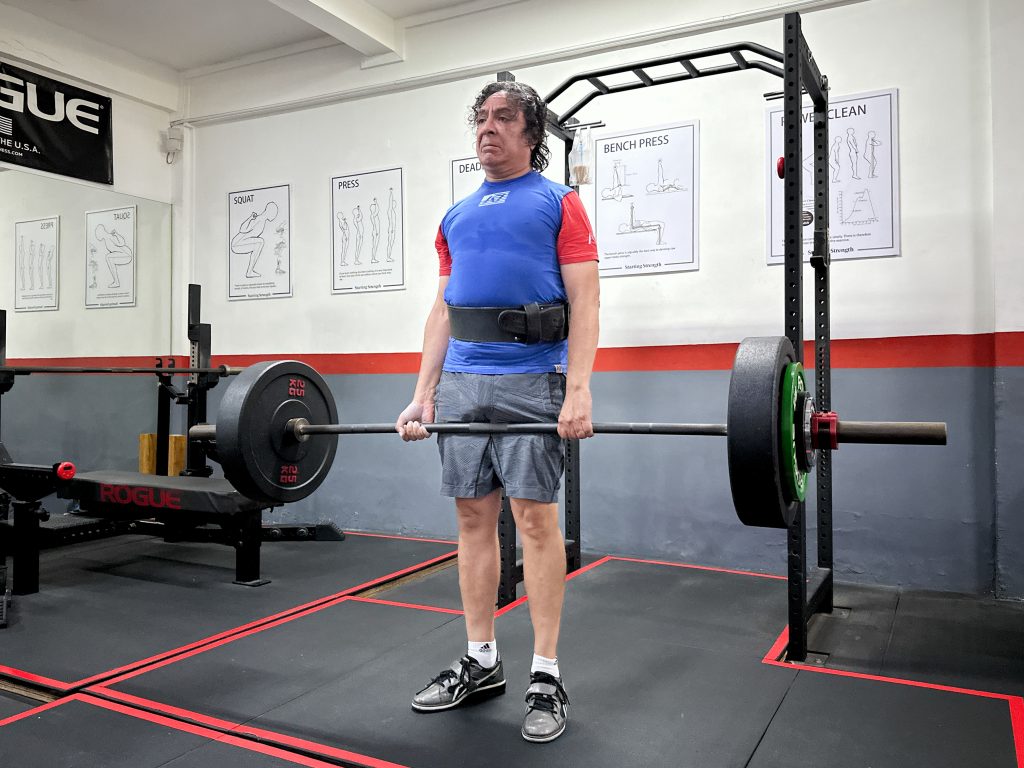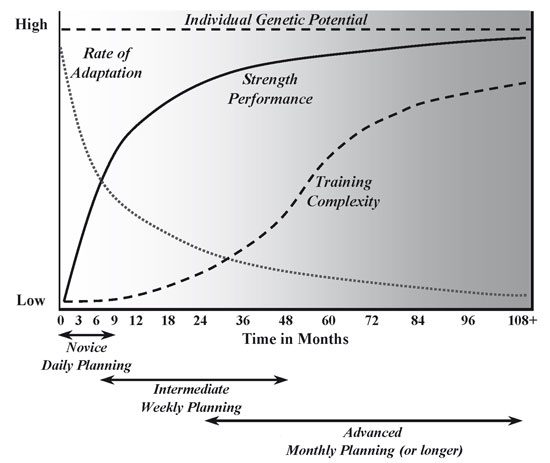
The best and easiest part of your training is when you first start. Every lifter remembers those glorious months: progress come fast, adding weight to the bar every session, strength climbing like a rocket. When you’re a novice on the Novice Linear Progression, it’ll be the fastest, easiest gains you’ll ever make.
As the months go by, training gets harder and progress starts to slow down. As more months go by, training gets even harder, and progress starts to slow down further.
A poor night’s sleep due to jet lag, a stressful day at work, or missing a meal can significantly impact your training session. These factors can make the workout feel much harder than it should be, sometimes even causing you to miss reps or requiring you to adjust the program to compensate.
Training progress is not smooth
That smooth, linear progress you experienced as a novice lifter won’t last forever. Enjoy it while it does, because as you advance in your training career, your progress will become less smooth and linear.
The expectation of smooth progress in any endeavour is simply human nature. The thick black line (“strength performance”) in the graph below shows how your rate of adaptation slows as you progress from novice onwards, yet it stays smooth – and that’s what we expect our progress to look like.

If you zoom out and take a macro view of your training, it should look like this model. But zoom in, take a micro view, and you’ll see little bumps and humps along the way – unexpected things show up, throwing a spanner in the works.
You’ll plan perfectly, execute flawlessly, and still face these bumps. Those aren’t failures. They’re data, for learning. And as long as the general trend keeps climbing upward, you’re winning.
Physical obstacles will happen
Your body will inevitably throw you curveballs. There are countless unexpected things that can affect your training, and most of them will happen when you least expect it.
Take my experience a few months back: I was dealing with some shoulder and neck discomfort and had to make adjustments to my bench press and press to work around it. While managing that injury, the rest of my lifts continued making solid progress. Just when the shoulder looked like it was finally healing and my squat was approaching my all-time PR, my adductor started getting slightly pissed off. It wasn’t anything catastrophic, no pull or tear, thankfully. It just started getting a little sore, giving me a warning sign that I needed to pay attention. Drawing on past experiences and data, instead of continuing to push, I dutifully adjusted my squat and deadlift programming.
Sometimes it feels like a game of whack-a-mole. But here’s what I’ve learned: I know when I should or shouldn’t push through, what can be done to work around these issues, and I know they’ll eventually resolve themselves. It just takes some know-how, time and patience.
Then there’s illness – something that unavoidable. When you get sick and need to take a forced break, you’ll detrain slightly depending on the illness, its severity and time away from training. But your strength will come back once you recover and get back under the bar.
I’ve had a client step on a glass shard and had to lay off training for weeks. When she was cleared to train, she started with pressing and benching, then gradually got back to squatting and deadlifting. Another client tweaked his knee putting on his underwear – we used pin squats, managing the situation by controlling range of motion and load until he could return to normal squatting. Both eventually went back to normal training. Shit happens, but we can work around it.
Also, as we age, our recovery capacity gradually decreases and rate of adaptation slows down. The good thing is that this can be pre-emptively accounted for. I’ve been working with my longest client for about 12 years now, and his recovery is different from when we first started. That’s expected and gets factored into his programming.
Life doesn’t care about your training schedule
Even when your body cooperates, life has its own plans for your training consistency.
I have a client who moved back to the US a few years ago. Continuing with online coaching, she never stopped training – but boy, was she busy. She was traveling around the country visiting friends, hunting for a home to settle down in, taking care of her new grandchild, and caring for her aging mother. Her plate was overflowing, and she was constantly on the move. But everywhere she went, she’d find a gym and made plans to train whenever her schedule allowed.
It wasn’t smooth sailing at all. She’d make solid progress, then training would get interrupted and she’d lose a bit of strength. But this didn’t faze her one bit – she understood that it would all work out in the end, and more importantly, she genuinely enjoyed the process of training.
This became her reality for a couple of years. Earlier this year, we caught a break with several months of uninterrupted training, and she managed to hit a new squat PR. We were tracking toward a new deadlift PR at the same time, but life intervened again with a forced break right when it was supposed to happen. Her reaction? No worries, no loss of enthusiasm. Just happy about that squat PR and gratitude for being able to train, knowing the deadlift PR would come eventually. Just not that day.
This doesn’t only happen when you’re relocating across countries. A new baby, a demanding job, frequent travel, a bad bout of insomnia – any of these can throw a massive wrench into your training plans. Maybe you’ve picked up a new sport that’s demanding its share of your body’s finite recovery capacity – forcing you to decide what’s more important at that stage and prioritise accordingly. Priorities shift constantly throughout life, and that’s completely normal.
The right mindset for long-term success
The biggest shift you can make is learning to look at the bigger picture. Every day is not Sunday. There’ll be good days and there’ll be bad days. Instead of getting frustrated if a session or a few sessions didn’t go well, a successful long-term mindset focuses on monthly or yearly trends. If you zoom out and the trend is still going up, you’re still getting stronger and doing well. If not, reassess the basics – are you training consistently, is it a programming issue, are you eating enough protein, and getting adequate sleep?
Practical strategies for imperfect circumstances
When you know that there’s going to be bumps coming up in your training, you need a plan.
First: talk to your coach. Discuss ways to maximise what you can do within your constraints. For example, if you know that you’re going to have an extremely busy period at work, which will require you to frequently burn the midnight oil, your training will need to be adjusted to accommodate. Lowering training volume but keeping intensity high is one way to hold on to as much strength as possible during this disruptive period.
If you’re traveling and feeling restless without “getting a workout in”, adapt to whatever’s available. Hotel gym with limited equipment? Work with it. If you’re lucky and there’s a proper gym close by, don’t do a full workout and spend too much time training. Work up to something heavy, something like one heavy set of five, and call it a day. Slows down detraining and keeps your family happy. I’d advise against making family revolve around your training schedule or disrupt holiday plans.
If you’re preparing for a competition, it depends on timing. Is the competition months away or weeks away? Are you gone for days or weeks? These factors dictate whether you need to continue training whilst away to perform well on the platform.
I recently told a very goal and numbers driven client that was on a three week holiday to forget about pushing the weights for now. He was travelling from place to place, trying to maintain his training schedule and push his numbers up. I told him the goal for these three weeks should to hold on to as much strength as possible – we can push when he’s back. He appreciated this and said it was good to remember. In the grand scheme of things, these weeks of “maintenance mode” will be just a tiny non-noticeable blip in your training career. The weights will always be there for you, waiting for your return. Enjoy your holiday.
Training and being strong is supposed to add value to your life, not subtract from it.
Training, like anything else worth pursuing, will be hard and fraught with bumps along the way. Even when you prepare as well as you can, life will throw you a curveball. Reassess, adjust, and keep plugging away. To quote Jean-Luc Picard: “It is possible to commit no mistakes and still lose. That is not a weakness; that is life.”

